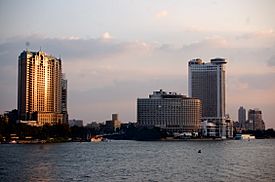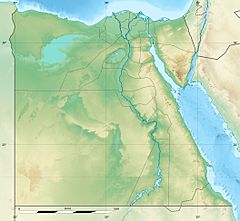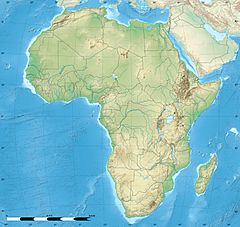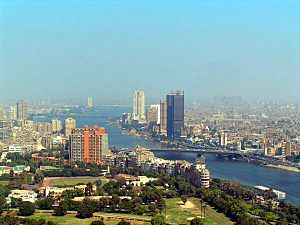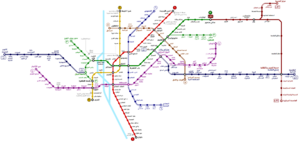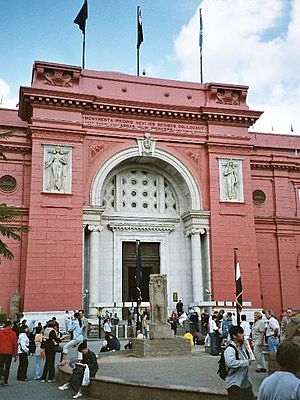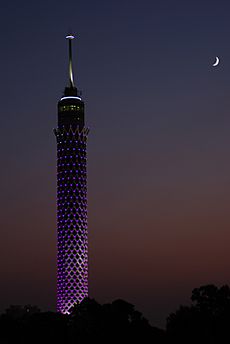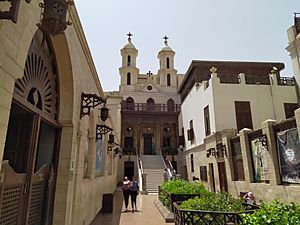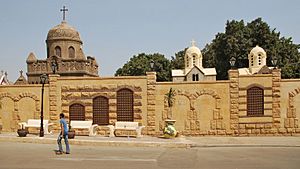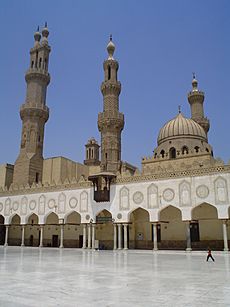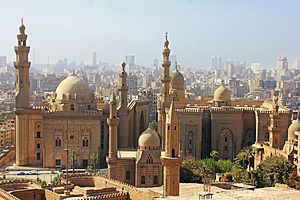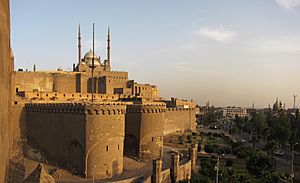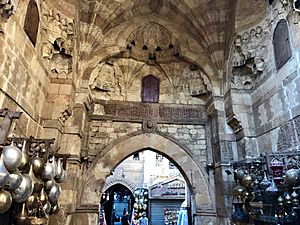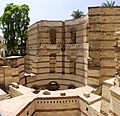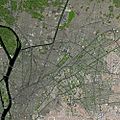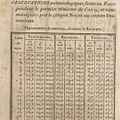Cairo facts for kids
Quick facts for kids
Cairo
القاهرة
|
||
|---|---|---|
|
Clockwise from top:
View of the Nile, Muizz Street, Baron Empain Palace, Cairo Citadel, Talaat Harb Square, Ibn Tulun Mosque |
||
|
||
| Nickname(s):
The City of a Thousand Minarets
|
||
| Country | ||
| Governorate | Cairo | |
| Founded | 969 CE | |
| Founded by | Fatimid dynasty | |
| Area | ||
| • Metropolis | 214 km2 (83 sq mi) | |
| • Metro | 17,267.6 km2 (6,667.1 sq mi) | |
| Elevation | 23 m (75 ft) | |
| Population
(2017)
|
||
| • Metropolis | 19,500,000 | |
| • Density | 19,376/km2 (50,180/sq mi) | |
| • Urban | 18,290,000 | |
| • Metro | 20,439,541 | |
| • Demonym | Cairene | |
| Time zone | UTC+2 (EET) | |
| Area code(s) | (+20) 2 | |
| Website | www.cairo.gov.eg | |
| Official name: Historic Cairo | ||
| Type: | Cultural | |
| Criteria: | i, iii, vi | |
| Designated: | 1979 | |
| State Party: | Egypt | |
| Region: | Arab States | |
Cairo (Arabic: القاهرة, also called Al-Qāhirah) is the capital and largest city in Egypt. Its name means "the one who won" or "the Conqueror". People sometimes call Cairo "Mother of the World" (Um al Dunya).
Cairo is a huge city with about 7.9 million people living in it. If you include the surrounding urban area, the population grows to about 17.2 million. This makes Cairo the biggest city in the Arab World and Africa.
The city is located right on the famous Nile River.
Contents
History of Cairo
The area around Cairo was very important in Ancient Egypt.
In the year 968, a group called the Fatimids came to Egypt. They chose Cairo to be the capital city of their caliphate (their kingdom).
The Al Azhar mosque and university was built in 972. It became one of the oldest universities in the world. Today, it is a very well-known place for Islamic studies.
In 1992, Cairo was hit by an earthquake. It was a 5.8 magnitude earthquake that caused 545 deaths and injured many people. About 50,000 people lost their homes.
Getting Around Cairo
Cairo has many ways to get around, like roads, trains, and a subway system. You can travel by car, taxi, public bus, or small vans called microbuses. Cairo International Airport is the biggest airport in Egypt.
Public Transportation
The Cairo Transportation Authority (CTA) runs Cairo's public transport. The Cairo Metro is a fast way to travel around the city. It reaches many suburbs.
The metro can get very crowded, especially during busy times. Two train cars are usually just for women. However, women can choose to ride in any car they like.
Long ago, Cairo also had trams and trolleybuses. But these were stopped in the 1970s. The last ones closed in 2014.
In 2017, plans were made to build two monorail systems. One will connect 6th of October to Giza, and the other will link Nasr City to New Cairo.
Roads in Cairo
Two major roads that cross Africa start in Cairo. These are the Cairo–Cape Town Highway and the Cairo-Dakar Highway. Cairo also has a large network of roads connecting it to other cities and villages in Egypt.
A new Ring Road goes around the city. It has exits to reach different parts of Cairo. There are also many bridges, like the 6th October Bridge. These bridges help people travel quickly across the city when traffic is not too heavy.
Cairo traffic can be very busy and crowded. Drivers are often aggressive, but they usually take turns at intersections. Police help control traffic in some busy areas.
Other Ways to Travel
- Cairo Taxi/Yellow Cab
- Cairo Nile Ferry
- Careem (ride-sharing service)
- Uber (ride-sharing service)
- DiDi (ride-sharing service)
Cairo's Climate
Cairo has a hot desert climate. This means it is hot, sunny, and dry for most of the year. However, it can also have more humidity than some other desert cities.
Things to See in Cairo
The famous pyramids of Giza and the step pyramid of Sakkara are very close to Cairo.
The Egyptian Museum has the world's largest collection of ancient Egyptian items. You can see many treasures from the tomb of King Tutankhamun there.
Food in Cairo
Many people in Cairo cook at home using fresh food from local markets. The city also has many restaurants. You can find Arab cuisine and Middle Eastern cuisine, including local dishes like koshary.
The fanciest restaurants are often in Zamalek and near the luxury hotels along the Nile River. You can also find many Western fast-food chains like McDonald's and KFC in central areas.
City Landmarks
Tahrir Square
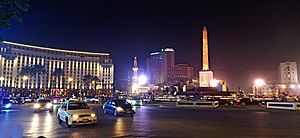
Tahrir Square was created in the mid-1800s. It was first named Ismailia Square. After the Egyptian Revolution of 1919, people started calling it Tahrir (Liberation) Square. It was officially renamed after the Egyptian Revolution of 1952.
Many important buildings are around the square. These include the American University in Cairo, the Mogamma government building, and the Egyptian Museum. Tahrir Square has been a key spot for major protests. It was the main gathering place during the 2011 Egyptian revolution against former president Hosni Mubarak.
In 2020, a new monument was put in the center of the square. It has an ancient obelisk from the time of Ramesses II and four sphinx statues.
Egyptian Museum

The Museum of Egyptian Antiquities, also known as the Egyptian Museum, holds the largest collection of ancient Egyptian items in the world. It has 136,000 items on display. Many more are kept in its storage rooms. The museum also displays treasures found in the tomb of Tutankhamun.
Grand Egyptian Museum
Much of the Egyptian Museum's collection, including the Tutankhamun items, will move to the new Grand Egyptian Museum. This new museum is being built in Giza. It was expected to open by the end of 2020.
Cairo Tower
The Cairo Tower is a tall tower with a restaurant at the top that slowly spins. From there, you can see amazing views of Cairo. It is located on Gezira Island in the Nile River.
The tower is 187 meters (614 feet) tall. This makes it 44 meters (144 feet) taller than the Great Pyramid of Giza. The Great Pyramid is about 15 kilometers (9 miles) away.
Old Cairo
This part of Cairo is called "Old Cairo" because it has remains of the ancient Roman fortress of Babylon. It also covers the original site of Fustat, which was the first Arab settlement in Egypt.
Old Cairo includes Coptic Cairo, which has many old Christian churches. Examples are the Hanging Church and the Greek Orthodox Church of St. George. Most of these are inside the old Roman fortress. This area also has the Coptic Museum, which shows the history of Coptic art. The Ben Ezra Synagogue, Cairo's oldest synagogue, is also here.
North of this Christian area is the Amr ibn al-'As Mosque. It was the first mosque in Egypt, built in 642 AD. It has been rebuilt many times since then.
Islamic Cairo
Cairo has many historic buildings from the Islamic era. These areas are often called "Islamic Cairo". You can find hundreds of mosques, tombs, and old buildings here.
The first mosque in Egypt was the Mosque of Amr ibn al-As. The Mosque of Ibn Tulun is the oldest mosque that still looks like it did when it was built. It was built in 876–879 AD. It is one of the largest and most beautiful mosques in Cairo. Another old building is the Nilometer on Roda Island, built in 862 AD. It was used to measure the Nile River's water level.
The city formally named Cairo was founded in 959 AD by the Fatimid army. They built it as a separate city with palaces and government buildings. It was surrounded by walls, and parts of these walls still exist today. Important buildings from the Fatimid time include the Mosque of al-Hakim and the Aqmar Mosque.
One of the most important places from the Fatimid period is the Mosque of al-Azhar, founded in 970 AD. It is one of the oldest universities in the world. Today, Al-Azhar University is a leading center for Islamic learning. The mosque has been added to and changed over many centuries.
Many beautiful buildings in medieval Cairo are from the Mamluk period (1250 to 1517 AD). The Mamluk rulers built many religious and educational centers. These often included a mosque, a school (madrasa), and a tomb for themselves. Famous Mamluk buildings include the huge Mosque-Madrasa of Sultan Hasan and the Mosque of Sultan al-Muayyad.
The Mamluks also built wikalas or caravanserais. These were like hotels for merchants and their goods. The Wikala of Al-Ghuri is still standing today and hosts performances. The Khan el-Khalili is a famous marketplace that also used to have caravanserais.
Citadel of Cairo
The Cairo Citadel is a strong fortress started by Saladin in 1176 AD. It was built on a hill to protect Cairo. It was the center of Egyptian government until 1874.
Today, the Citadel is a popular place for tourists. It has the National Military Museum. You can also see the 14th-century Al-Nasir Muhammad Mosque and the 19th-century Mosque of Muhammad Ali. This mosque stands out on Cairo's skyline.
Khan el-Khalili
Khan el-Khalili is a very old bazaar (marketplace) next to the Al-Hussein Mosque. It started in 1385 when a large caravanserai (a hotel for traders) was built there. This caravanserai was later rebuilt as a new shopping area in the early 1500s.
Many old parts of the market, like the beautiful Mamluk-style gateways, are still there. Today, Khan el-Khalili is a major tourist spot.
Famous People from Cairo
People from Cairo are called 'Cairenes'. Here are some famous ones:
- Boutros Boutros-Ghali - former Secretary-General of the United Nations.
- Naguib Mahfouz - novelist, won the Nobel Prize in Literature in 1988.
- Mido - professional soccer player.
- Mohamed ElBaradei - Director General of the International Atomic Energy Agency, won the Nobel Peace Prize in 2005.
- Naguib Sawiris - a very wealthy businessman.
- Farouk El Baz - a scientist who helped NASA.
- Sir Magdi Yacoub - a leading heart doctor.
Images for kids
-
Excavated ruins of Fustat (2004 photo)
-
The Mosque of Ibn Tulun, built by Ahmad Ibn Tulun in 876–879 AD
-
The Cairo Citadel, seen above in the late 19th century, was begun by Saladin in 1176
-
Mausoleum-Madrasa-Hospital complex of Sultan Qalawun, built in 1284–1285 in the center of Cairo, over the remains of a Fatimid palace
-
Map of Cairo in 1809, from the Description de l'Égypte.
-
Louis Comfort Tiffany (1848–1933). On the Way between Old and New Cairo, Citadel Mosque of Mohammed Ali, and Tombs of the Mamelukes, 1872. Oil on canvas. Brooklyn Museum
-
The river Nile flows through Cairo, here contrasting ancient customs of daily life with the modern city of today.
-
Aerial view looking south, with the Zamalek and Gezira districts on Gezira Island, surrounded by the Nile
-
View of the Nile and the Cairo skyline.
-
Cairo University is the largest university in Egypt, and is located in Giza.
-
Cairo International Stadium with 75,100 seats
See also
 In Spanish: El Cairo para niños
In Spanish: El Cairo para niños


